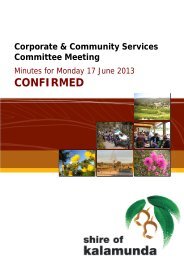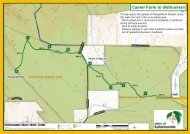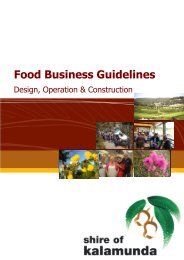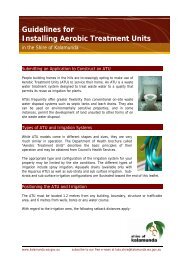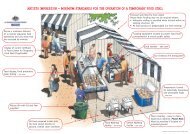Local Biodiversity Strategy: - Shire of Kalamunda
Local Biodiversity Strategy: - Shire of Kalamunda
Local Biodiversity Strategy: - Shire of Kalamunda
You also want an ePaper? Increase the reach of your titles
YUMPU automatically turns print PDFs into web optimized ePapers that Google loves.
5.2.3 How will natural areas be protected?<br />
Implementation <strong>of</strong> the <strong>Local</strong> <strong>Biodiversity</strong> <strong>Strategy</strong> will assist in the protection <strong>of</strong> LNAs<br />
through consideration <strong>of</strong>:<br />
• biodiversity when preparing detailed local structure plans;<br />
• assessing subdivision and development applications with more rigorous<br />
ecological criteria; and<br />
• making minor amendments to the <strong>Local</strong> Planning Scheme No.3.<br />
This will be assisted by the development <strong>of</strong> a <strong>Local</strong> Planning Policy for <strong>Biodiversity</strong><br />
Conservation. The <strong>Local</strong> Planning Policy will provide a formalised and equal<br />
assessment process for each development proposal likely to affect LNAs. A detailed<br />
desktop assessment and on-ground surveys may be required prior to any approvals<br />
or work commencing.<br />
Between 2001 and 2005, 59 ha <strong>of</strong> endemic vegetation were cleared, mostly in LNAs.<br />
Indicating therefore the future <strong>of</strong> LNAs is uncertain and the remaining LNAs be<br />
considered as retained but not protected. The LBS aims to increase the protection <strong>of</strong><br />
these areas. For the purposes <strong>of</strong> this report, an area will be protected if:<br />
• Public land has been vested for the purposes <strong>of</strong> conservation;<br />
• Private land is covered by a management agreement <strong>of</strong> at least 5 years; or<br />
• Private land has a permanent conservation covenant.<br />
It should also be noted that protected natural areas will need to be managed to<br />
alleviate the threats to biodiversity and funds will need to be allocated. Generally<br />
larger areas in good or excellent condition require less maintenance than smaller<br />
more degraded areas.<br />
5.2.4 How will natural areas be identified?<br />
<strong>Local</strong>ly significant natural areas in the <strong>Shire</strong> <strong>of</strong> <strong>Kalamunda</strong> have been identified using<br />
the criteria detailed in the <strong>Local</strong> Government <strong>Biodiversity</strong> Planning Guidelines. The<br />
standard ecological criteria for local biodiversity planning are grouped under the<br />
following themes:<br />
• Representation <strong>of</strong> ecological communities;<br />
• Diversity;<br />
• Rarity;<br />
• Maintaining ecological processes or natural systems – connectivity; and<br />
• Protecting wetland, streamline and estuarine fringing vegetation.<br />
These criteria have also been used to develop local biodiversity targets which are<br />
detailed in Part B.<br />
<strong>Local</strong> <strong>Biodiversity</strong> <strong>Strategy</strong> Page 28



